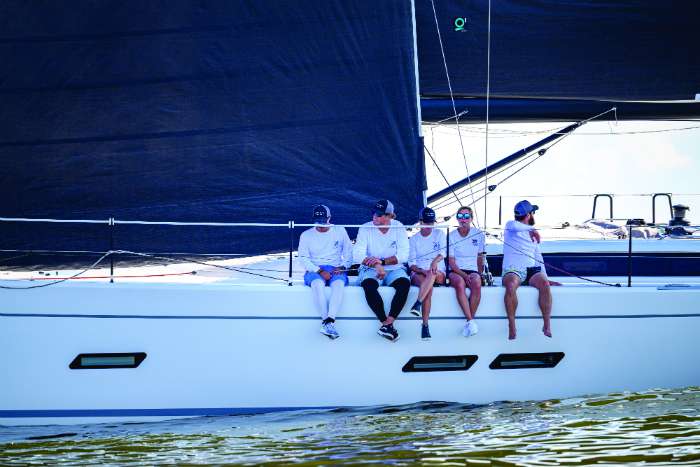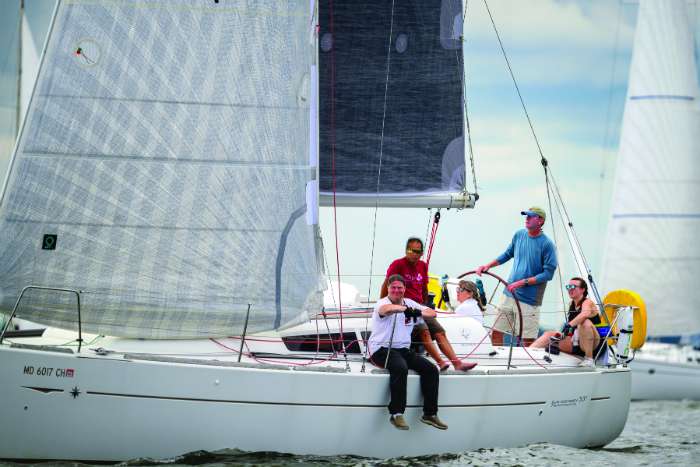Sailors — Up Your Distance Racing Game!
It’s that time of year when there are a number of big distance sailing races which attract many Chesapeake Bay sailors such as the EYC Boomerang Race and Governor’s Cup. There is no way to guarantee success at such events. Distance racing presents more variables than short-course racing and as such is harder to do well at. It takes a bit of luck.

The weather gods are always cruel and unpredictable, and there is a certain randomness based on boat size. Does it turn out to be a big boat race, or do the small boats come in on a wave of new breeze to win on handicap? The only way to ultimately win the big one is to do a lot of them. Sail 15 Bermuda races, and your number will be more likely to come up. There are, however, a number of common attributes that the teams that are consistently successful share. I offer these six thoughts on distance racing success.
1. Remember that trimmers and drivers are the key.
As you organize your team, remember it is all about consistent boat speed and the ability to push the boat as hard as possible for as long as possible. This means you need folks who can steer and trim. For around-the-buoys racing there is room for a couple of less skilled players in the middle who can be learning the ropes and helping with mechanics. Setting up a team for distance events means loading up on the skill positions. I might bring a great bow person and nobody else for the middle. A good driver can usually remember how to stumble through the mechanics of running the pit and will probably want to show off their bow skills.
2. Remember that races are won (or lost) at night.
The hours between 10 p.m. and first light are when the wheat is separated from the chaff. It’s hard to drive and trim well in the dark. Your watch system needs to be set up with this in mind. Your best drivers need to be ready to work hard after midnight. During the daylight you can get less experienced team members the time on the helm they will need to develop. This means you need a good watch system and watch discipline.
The classic half-crew on and half-crew off with four-hour watches may work well for some, but there are other approaches to the problem. A staggered watch with a new crew or two coming up every two hours helps maintain continuity and avoids a distributive wholesale change. Sometimes you can break the team down so that the four best helmspeople are split up and staggered and there is always a good new driver up every two hours.

Consider shortening the watch system at night. For most less-than-hardcore distance sailors three hours at night is plenty. Switch to four hours during the day. There is also a tendency at the start of a distance race for everybody to be all fired up. The whole crew stays on deck for the first 10 or 12 hours. Later, everybody falls apart. If the race starts at 1 p.m., start the watch system at 4 p.m., and make sure the people who are supposed to be off watch are off. The sooner you can get into a rhythm the better.
On shorter races where there may not be a full-scale watch system, use light air to prepare for more breeze. If you are dribbling downwind in six knots of wind, send everyone but the two or three you need on deck down below to sleep or rest. Their weight will be better there anyway. When the breeze comes up and you are power reaching or beating, you can ask everyone to get up on the rail and hike.
3. Pay attention to crew decorum.
One last thought on watch discipline. Never be late on deck to relieve your teammates! Be five minutes early. It takes more time than you think to get ready, especially if it is windy and you have a lot of gear to get on. When you are coming off watch, make sure your new on-deck staff is well briefed on what is going on and how things are setup and being trimmed.
As a courtesy, wake up the oncoming watch 15 to 20 minutes before they have to be on deck. Take your time to get out of wet gear. Never get into a bunk wet! Make sure you sleep where your weight is appropriate and be prepared to shift if the boat tacks or gybes. In addition to a lifejacket and harness with all associated gear, every crew member should have a personal strobe, knife, and headlight. Personal locator beacons and whistles are great ideas. No lights down below! You have to make sure the folks doing the hard work on deck don’t lose their night vision. Oh, and bring all your clothes and eat when you can.

4. Forget preconceived notions.
How many times have you heard that you always go down the western shore when doing a Down the Bay Race on the Chesapeake? Or, you always go to the west of the rhumb line on the Newport Bermuda Race? It’s not true! You have to be ready to sail the conditions you have. Use all the modern weather and routing options you can find to help you anticipate what you might encounter and develop a plan, but don’t forget the basics such as heading toward the mark and sailing the long tack first. I can’t begin to tell you how many Governor’s Cups and Solomons Races have been won by the boat beating down the Bay that went straight on starboard almost fetching and got lifted in the end spending little or no time on port. All those who tacked early (because you always go west) were far behind because they had wasted time on port tack.
5. Start by winning the neighborhood.
Unfortunately, there is always some clown who is going to bang the corner and get lucky. In a Bermuda race with 250 boats the spread from east to west across the rhumb line could be more than 100 miles. One of those extremes could work. If they do, so be it. The smart money will use a more conservative strategy. The best bet is to stay with a group of well-sailed boats of similar speed and use each other to push the boat at all times. All I can do is win my neighborhood; I can’t control the boat with miles of leverage in a corner.
6. Remember that the rhumb line is irrelevant.
The line you draw on the chart from start to finish is meaningless. You should not care if you are one mile or 10 miles off that imaginary line. All you care about is the distance to the finish from where you are. You should imagine a series of concentric circles emanating from the finish at 10 miles apart. The game is to get up these ladder rungs as fast as possible regardless of how far left or right from the original rhumb line you are. The weather is going to change. A simple example: I can just fetch sailing hard on wind on port. Cracked off 10 degrees I cannot sail straight to the mark, but I am two knots faster. Later the wind shifts to the left, and I can fetch, but since I have been sailing two knots faster for the last 12 hours, I am more than 20 miles closer to the mark. Voilà!
Distance racing definitely brings out the physical nature of our sport. There will be suffering. You will be cold, wet, miserable, hungry, and tired. It is kind of like distance running or biking. It feels great when you stop. For the same reasons it will provide immense pride just to have made it and a lifetime of memories and bonding experiences. Take these tidbits and go out and enjoy! ~By David Flynn of Quantum Sails
A version of this article first appeared in the June 2019 SpinSheet.
Questions? Email [email protected] ... Find more Racer's Edge Tips here.




